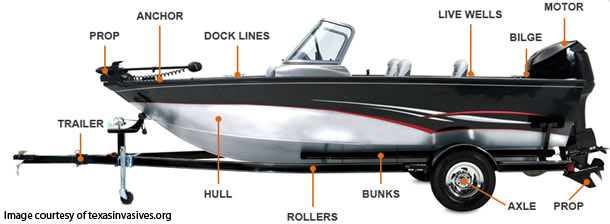
Watercraft
To prevent the spread of aquatic invasive species (AIS) such as zebra mussels, all water-users must take the following steps before launching or moving watercraft (ex: Jet SkisŪ, canoes), water-related equipment (ex: trailers, removable docks, fishing gear, anchors), aircraft (ex: float planes), motor or off-road vehicles (ORVs) from one water body into another water body:
Before launching a watercraft or placing water-related equipment into a water body in Manitoba, ensure they are free of:
- aquatic invasive species,
- aquatic plants,
- mud, and
- standing water.
When draining standing water, ensure it does not enter any water body or storm sewer. Use a dry towel to remove any residual water found in compartments.
When removing a watercraft or water-related equipment from a water body in Manitoba:
1. CLEAN and remove AIS and aquatic plants before leaving the shore of the water body.
Inspect the watercraft and water-related equipment, including the trailer and motor vehicle visually. Meanwhile, run your hands over the surfaces that were submerged in the water (ex: hull, lower unit of motor, trailer). AIS such as recently settled zebra mussels feel like sandpaper, but may not be noticeable to the naked eye.

Common places where aquatic invasive species like zebra mussels can be found on a watercraft, and water-related equipment such as the trailer and anchor.
2. DRAIN all water from the watercraft (ex: ballast tanks, motor, live well, compartments) and water-related equipment (ex: bait bucket) before leaving the shore.
ALL drain plugs must be kept out while transporting watercraft over land with the exception of plugs used in onboard kitchen and washroom facilities.
3. DRY completely or decontaminate water- related equipment before placing into another water body.
Any hard-to-drain areas or compartments of a watercraft or water-related equipment should be dried with a towel. Leave live wells, bait buckets and storage compartment doors open to allow for drying. Note:
Drying times increase greatly in the spring and fall due to increased humidity and lower temperatures.
Larval zebra mussels, called veligers require water to survive and will die out of water. Adult zebra mussels (with shells) can survive up to 30 days out of water in damp, cool conditions.
4.DISPOSE of all bait used in a provincial-designated control zone water body in the trash prior to leaving the shore. This is regardless of possessing a 3-day live bait fish transfer and use receipt. For more information on control zones, click here. Always dispose of unwanted bait in the trash. Refer to the Manitoba Anglers' Guide for more information on bait use.
5. DECONTAMINATE IF watercraft or water-related equipment were used last in a provincially-designated control zone and before placing into another water body. For more information on control zones, click here. Information on how to decontaminate watercraft or water-related equipment can be found here.
The AIS Open-water Season and Winter (Ice-covered) Season checklists are step-by-step resources that can help you comply with the Manitoba government's AIS Regulation.
Report an Aquatic Invasive Species online, or call 1-87-STOP AIS-0 (1-877-867-2470) if you discover:
- zebra mussels in a water body other than Lake Winnipeg or the Red River,
- AIS outside an area not designated as a control zone for that species, or
- a new AIS.
Aquatic Invasive species such as zebra mussels, quagga mussels, spiny waterflea, rusty crayfish, and four species of invasive (Asian) carp are listed in schedules attached to the Aquatic Invasive Species Regulation (SOR/2015-0212) under the federal Fisheries Act and the Aquatic Invasive Species Regulations under The Water Protection Act. Possessing any of these listed species in Manitoba is illegal. To learn about the species subject to prohibitions and controls visit the federal Aquatic Invasive Species Regulation site at the Canadian government's law website, by clicking here.

